Ministers were today urged to adopt stricter targets on air pollution amid claims the Government has ‘dragged its heels’ in the fight on toxic air.
The World Health Organization’s recommended target — updated for the first time in 15 years today — is half the level of No10’s proposed limit.
Politicians have yet to pass through the threshold as law, with the bill currently being debated in the House of Lords.
But charities today urged ministers to act on the WHO advice, saying its proposed limits on pollution are ‘unfit for purpose’. Toxic air will ‘continue to blight the health of generations to come’ without urgent intervention, they warned.
And the mother of a nine-year-old girl, who was the first person in the UK to have air pollution recorded on her death certificate, has called on the Government to follow the WHO’s new guidelines.
The UN agency, which last updated its guidance in 2005, demanded tougher action as evidence continues to build over the health risks of tiny pollutants, linked to heart disease, dementia and cancer.
Poor air quality is estimated to cause 7million deaths every year and cuts millions of healthy years off lives, according to the WHO.
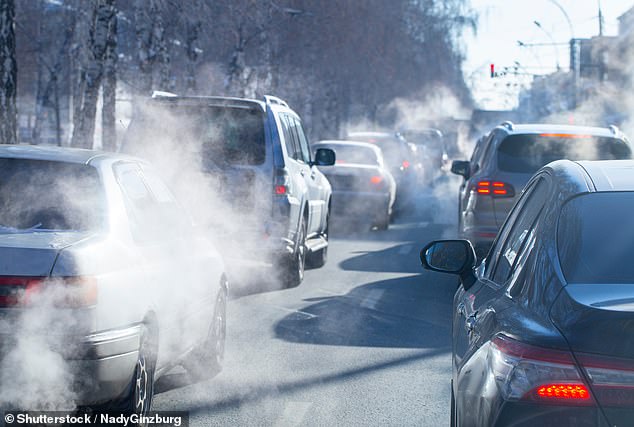
The WHO released air quality guidelines to protect people’s health, calling on countries to ensure key air pollutants do not go above a certain level. The guidelines state levels of particulate matter that are smaller than 2.5 microns (µg/m³) should not exceed an annual level of 5 µg/m³, according to the recommendations – half the level included in the Environment Bill going through Parliament.
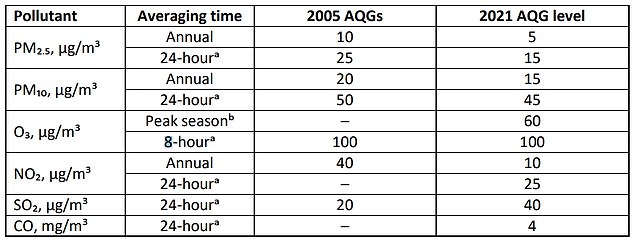
The WHO’s guidelines set new targets for so-called classical pollutants, particulate matter (PM 2.5 and PM 10), ozone (O2), nitrogen dioxide (NO2), sulfur dioxide (SO2) and carbon monoxide (CO). Almost all of the targets are less than those it recommended in 2005, because researcher in the last 16 years has highlighted the impact of pollution on health

WHO Europe Regional Director Dr Hans Henri Kluge said the impact of air pollution on diseases is ‘large, it is growing, and makes air pollution the single most important environmental risk factor for our health’
Mum of girl whose death was linked to pollution says UK must adopt new clean air goals
The mother of a nine-year-old girl in London, whose death was linked to air pollution, has called on the UK Government to adopt new air pollution targets.
Rosamund Adoo-Kissi-Debrah’s daughter Ella’s death in February 2013 following an asthma attack.
A coroner ruled in December that pollution contributed to her death.
She lived nearby the South Circular Road in Lewisham and is believed to be the first person in the UK to have air pollution recorded on her death certificate, after Southwark Coroner’s Court found it was a ‘material contribution’ to Ella’s death.
Ms Adoo-Kissi-Debrah said ministers now have a ‘once-in-a-generation opportunity to protect children’s health’ by updating air quality targets to follow latest guidelines from the World Health Organisation.
She said: ‘Air pollution stunts children’s health and future – it causes premature birth, life-threatening asthma, cognitive problems, childhood cancer and so many other problems.

Pictured: nine-year-old Ella Kissi-Debrah
‘There is no safe level of air pollution to breathe, but at least following the WHO’s new air quality guidelines will improve children’s health and set us on the path to achieving clean air for all.
‘The UK government has a once-in-a-generation opportunity to protect children’s health now, by including air quality targets in the Environment Bill that follow the WHO’s guidelines.
‘This bill will determine the quality of the air we breathe for the next 15-20 years – meaning that babies born today will grow up with it. We can’t let them down.
‘The Coroner’s report on preventing future deaths like my daughter Ella’s said that aligning PM2.5 pollution with the WHO’s guidelines would be a minimum requirement for saving lives.
‘And yet our Government wants to put the air quality targets out for consultation from January to October 2022.
‘It’s incredibly disappointing to see Prime Minister Boris Johnson telling other countries at the UN this week that they are not doing enough to tackle climate change, when his own government is still supporting new fossil fuel projects and delaying air quality targets that will save lives now and help reach net zero emissions by 2050.’
Advertisement
The WHO’s guidelines urged countries to ensure air pollutants, such as particulate matter (PM) and nitrogen dioxide (NO₂), do not exceed a certain level.
Levels of PM that are smaller than 2.5 microns (µg/m³) should not exceed an annual level of 5 µg/m³, according to the recommendations – half the level included in the Government’s Environment Bill and a fifth of the cap included in current regulations.
It is also half of the level it recommended in its old 2005 guidelines.
And short-term exposure — the level a person is exposed to for a maximum of four days per year — should not be higher than 15 µg/m³, compared to the previously recommended 20 µg/m³.
Tiny particulate matter are some of the most dangerous pollutants because they are capable of penetrating deep into the lungs and bloodstream, damaging the body’s organs.
They have also been linked with cancer and are mainly made from burning fuel for transport, energy and agriculture.
WHO Europe Regional Director Dr Hans Henri Kluge said the impact of air pollution on diseases is ‘large, it is growing, and makes air pollution the single most important environmental risk factor for our health’.
He said: ‘Everybody on the planet has the fundamental right to breathe clean air. Like most environmental factors, air pollution does not respect national boundaries.
‘The nature of this challenge calls for an enhanced and immediate action, because clean air is a political choice and a societal responsibility.
‘The next step is now for policymakers around the world to use these guidelines to develop evidence-informed policies to decrease the unacceptable health burden that results from air pollution exposure.
‘The urgent actions that are needed require sustained political commitment and cooperation of various sectors and stakeholders.’
In 2019, more than 90 per cent of the world’s population lived in areas where PM 2.5 levels were higher than the WHO’s 2005 guidelines.
The WHO said almost eight in 10 deaths related to PM 2.5 could be avoided if levels were reduced in line with its new guidelines.
And even if countries lower it to the old target of 10 µg/m³ of PM 2.5 each year, 48 per cent of deaths related to the pollutant would not occur, with the biggest impact seen in South East Asia and Africa.
Addressing other key pollutants, the WHO set a new ozone (O3) level of 60 µg/m³ at the peak in summer, while short-term exposure should not be more than 100 µg/m³ – the same level it recommended in its 2005 guidelines.
And target levels of NO2 should be 10 µg/m³ annually, a quarter of the previous recommended level of 40 µg/m³, the WHO said.
Current UK guidelines state NO2 levels must not exceed 40 µg/m annually.
The WHO also introduced a recommended limit of 4 µg/m³ in a 24-hour period for carbon monoxide.
But the WHO increased levels of sulfur dioxide (SO2) that can be permitted because higher levels of this pollutant are comparably not as damaging as the others is set targets on.
The WHO said the figures are a ‘practical instrument’ countries can use to set goals or legally binding standards for air quality nationally and at a local level.
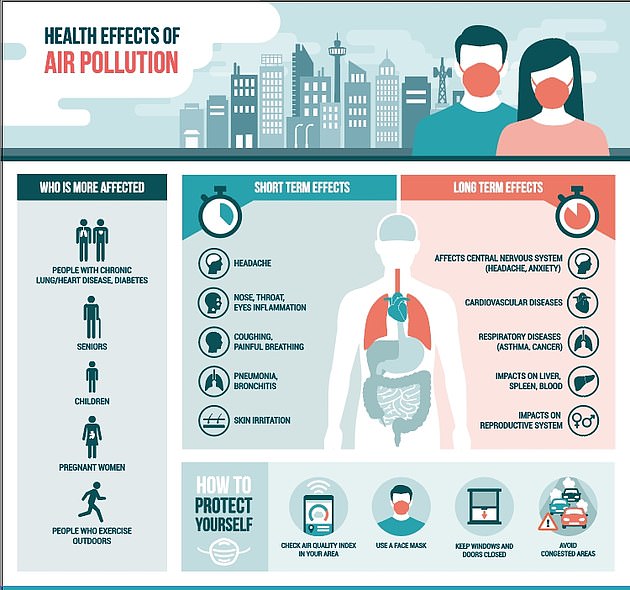
Air pollution increases the risk of several conditions, including heart attack, stroke and diabetes
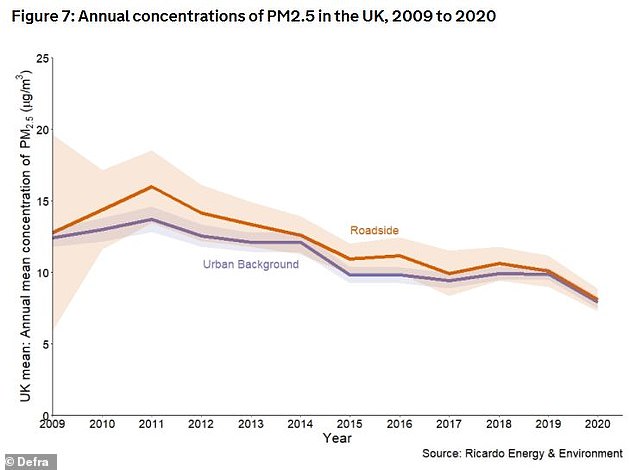
Three of the most problematic pollutants — nitrogen dioxide (NO2) and particulate matter (PM2.5 and PM10) — dropped to all-time low concentrations last year in the UK. Pictured, the level of PM2.5 since records began in 2009 for urban areas (purple) and by roads (red)

PM10, larger particles which pose less of a health risk to people, dropped from 15µg/m3 in urban areas in 2019 to 13.2µg/m3 last year — a 12 per cent drop (pictured)
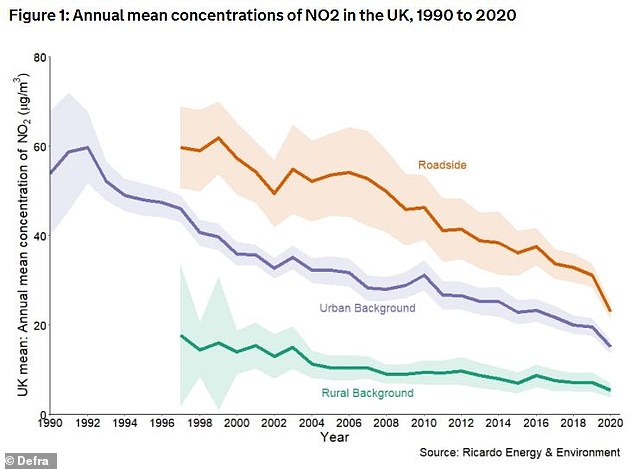
Pictured, a graph showing three measures of nitrogen dioxide, a pollutant primarily produced by engines and the burning of fossil fuels. The urban background annual average (purple) dropped by almost a quarter (23 per cent) in 2020
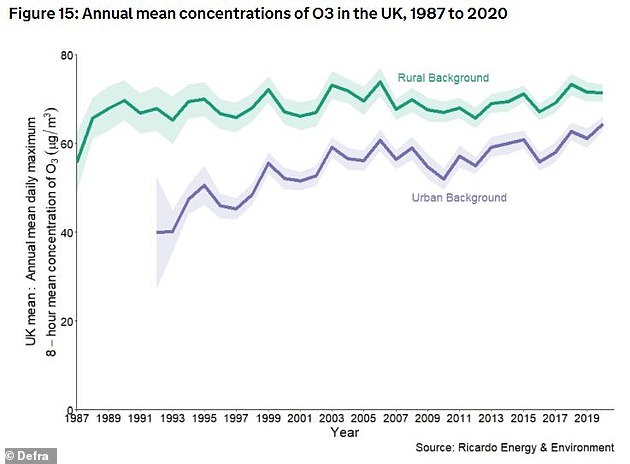
Ozone (O3) levels increased slightly in urban areas (purple), likely as a side effect of nitrogen dioxide emissions decreasing. Ozone is not produced in notable amounts by human activities, but instead is formed when various other emissions react in the atmosphere
WHAT HAVE RECENT STUDIES SHOWN POLLUTION CAN DO TO OUR HEALTH AND BODIES?
CAUSE CHILDREN TO HAVE A LOW IQ: Researchers at the University of California, San Francisco, found in May 2019 that children born to mothers who live in polluted areas have an IQ that is up to seven points lower than those living in places with cleaner air.
CAUSE CHILDREN TO HAVE POORER MEMORY: Researchers at the Barcelona Institute for Global Health found boys exposed to greater levels of PM2.5 in the womb performed worse on memory tests by the time they are 10.
DELAY THE DEVELOPMENT OF CHILDREN: Youngsters who live less than one-third of a mile away from busy roads are twice as likely to score lower on tests of communication skills in infancy, found researchers at Eunice Kennedy Shriver National Institute of Child Health in April. They were also more likely to have poorer hand-eye coordination.
MAKE CHILDREN MORE ANXIOUS: University of Cincinnati scientists claimed pollution may alter the structure of children’s brains to make them more anxious. Their study of 14 youngsters found rates of anxiety was higher among those exposed to greater levels of pollution.
CUT YOUR CHILD’S LIFE SHORT: Children born today will lose nearly two years of their lives because of air pollution, according to a report by the US-based Health Effects Institute and the University of British Columbia in April 2019. UNICEF called for action on the back of the study.
RAISE A CHILD’S RISK OF AUTISM: Researchers at Monash University in Australia discovered youngsters living in highly polluted parts of Shanghai have a 86 per cent greater chance of developing ASD. Lead author Dr Yuming Guo said: ‘The developing brains of young children are more vulnerable to toxic exposures in the environment.’
CAUSE ASTHMA IN CHILDREN: Four million children around the world develop asthma each year because of road traffic pollution, a major study by academics at George Washington University estimated. Experts are divided as to what causes asthma – but exposure to pollution in childhood increases the risk by damaging the lungs.
MAKE CHILDREN FAT: University of Southern California experts found last November that 10 year olds who lived in polluted areas when they were babies are, on average, 2.2lbs (1kg), heavier than those who grew up around cleaner air. Nitrogen dioxide pollution could disrupt how well children burn fat, the scientists said.
LEAVE WOMEN INFERTILE EARLIER: Scientists at the University of Modena, Italy, claimed in May 2019 that they believe pollution speeds up ageing in women, just like smoking, meaning they run out of eggs faster. This was based on them finding almost two-thirds of women who have a low ‘reserve’ of eggs regularly inhaled toxic air.
RAISE THE RISK OF A MISCARRIAGE: University of Utah scientists found in January that pregnant women are 16 per cent more likely to suffer the heartbreak of a miscarriage if they live in areas of high pollution.
RAISE THE RISK OF BREAST CANCER: Scientists at the University of Stirling found six women working at the same bridge next to a busy road in the US got breast cancer within three years of each other. There was a one in 10,000 chance the cases were a coincidence, the study said. It suggested chemicals in the traffic fumes caused the cancer by shutting down the BRCA genes, which try to stop tumours growing.
DAMAGE A MAN’S SPERM: Brazilian scientists at the University of Sao Paulo found in March that mice exposed to toxic air had lower counts and worse quality sperm compared to those who had inhaled clean air since birth.
MAKE MEN LESS LIKELY TO GET SEXUALLY AROUSED: Scientists at Guangzhou Medical University in China found rats exposed to air pollution struggled to get sexually aroused. Scientists believe it may also affect men, as inhaling poisonous particles may trigger inflammation in blood vessels and starve the genitals of oxygen – affecting men’s ability to become sexually aroused.
MAKE MEN MORE LIKELY TO HAVE ERECTILE DYSFUNCTION: Men who live on main roads are more likely to have difficulty getting an erection due to exposure to pollution, a Guangzhou University in China study suggested in February. Toxic fumes reduced blood flow to the genitals, tests on rats showed, putting them at risk of developing erectile dysfunction.
RAISE THE RISK OF PSYCHOSIS: In March, King’s College London scientists linked toxic air to intense paranoia and hearing voices in young people for the first time. They said uncovering exactly how pollution may lead to psychosis should be an ‘urgent health priority’.
MAKE YOU DEPRESSED: Massachusetts Institute of Technology researchers found in January that that the more polluted the air, the sadder we are. Their study was based on analysing social media users in China alongside the average daily PM2.5 concentration and weather data where they lived.
CAUSE DEMENTIA: Air pollution could be responsible for 60,000 cases of dementia in the UK, researchers from King’s College London and St George’s, University of London, calculated last September. Tiny pollutants breathed deep into the lungs and enter the blood stream, where they may travel into the brain and cause inflammation – a problem which may trigger dementia.
Advertisement
As it stands, the Government’s Environment bill — which will be published for a public consultation early next year — says PM 2.5 must be less than or equal to 10 µg/m³ and follow WHO targets ‘as far as practicable’.
A Defra spokesperson said: ‘Air pollution has reduced significantly since 2010 – at a national level emissions of fine particulate matter have fallen by 11 per cent, while emissions of nitrogen oxides are at their lowest level since records began.
‘To continue to drive forward tangible and long-lasting improvements to the air we breathe, we will set stretching and ambitious targets on air quality through our Environment Bill.
‘We will consider the updated WHO guidelines on PM2.5 to inform the development of air quality targets but we must not underestimate the challenges these would bring particularly in large cities and for people’s daily lives.
‘We must all understand the impact of the choices we need to make, which is why we will be running a public consultation on the proposed targets early next year which will inform the target setting process alongside independent expert advice and analysis on a range of factors.’
But Ms Woolnough said: ‘The Government has dragged its heels long enough.
‘With this latest WHO guidance, COP26 on the horizon and the Environment Bill going through parliament, now is the time for politicians to commit to world-leading air pollution targets to tackle the greatest environmental threat to human health.
‘We have a front row seat to the devastation caused by breathing in dirty air which creates new lung conditions, worsens existing ones and triggers life-threatening asthma attacks, and it’s plain to see that the Government’s current air quality legal limits are unfit for purpose.
‘The WHO’s revised air quality guidelines set the bar for the ambition needed by this Government, as well as world leaders, to prevent tens of thousands of early deaths each year.
‘They also support the urgent need to safeguard those most at risk from toxic air, including all people with lung conditions, children, pregnant women, and the elderly.
‘Our analysis shows that 99.8 per cent of schools in England are in areas where air pollution exceeds the WHO’s new guideline limits, an increase of almost 70 per cent from the 2005 guidelines.
‘Without urgent intervention, toxic air will continue to blight the health of generations to come.’
Rosamund Adoo-Kissi-Debrah, the mother of nine-year-old Ella who died in February 2013 following an asthma attack that a coroner concluded air pollution contributed to, said the Government ‘has a once-in-a-generation opportunity to protect children’s health now, by including air quality targets in the Environment Bill that follow the WHO’s guidelines’.
She said: ‘This bill will determine the quality of the air we breathe for the next 15-20 years – meaning that babies born today will grow up with it. We can’t let them down.
‘The Coroner’s report on preventing future deaths like my daughter Ella’s said that aligning PM 2.5 pollution with the WHO’s guidelines would be a minimum requirement for saving lives.
‘And yet our government wants to put the air quality targets out for consultation from January to October 2022.
‘It’s incredibly disappointing to see Prime Minister Boris Johnson telling other countries at the UN this week that they are not doing enough to tackle climate change, when his own government is still supporting new fossil fuel projects and delaying air quality targets that will save lives now and help reach net zero emissions by 2050.’
The WHO did not recommend ways for countries to tackle air pollution levels, but noted that lockdown measures implemented by Covid slashed NO2 levels by up to 70 per cent.
Restrictions in response to Covid ‘have shown how policies related to transport and the way people work, study and consume, can contribute to better air quality’, which countries should consider when implementing post-pandemic recovery policies.
Dr Aaron Bernstein, the interim director of the Center for Climate, Health and the Global Environment at Harvard T.H. Chan School of Public Health, said the health gains from moving away from from fossil fuels are ‘enormous’.
He said: ‘Air pollution from burning fossil fuels is responsible for 1 in 5 deaths worldwide.
‘It causes children to have asthma, it causes pneumonia, it causes pregnant women to have babies born prematurely and with more birth defects, and it’s increasing the risk of people who are dying from Covid right now.
‘Burning fossil fuels harms everybody, but especially the poor because air pollution makes worse the very injustices we are trying to combat.
‘At COP26, the world must urgently commit to phasing out fossil fuels so we can deliver the healthier, more just, and sustainable world that our kids deserve.’
Professor Stephen Holgate, Medical Research Council Clinical Professor of Immunopharmacology, said achieving the PM 2.5 targets is an important step for the Government.
He said: ‘But we must be aware that recent research shows there are no “safe” levels of air pollutants and, therefore, that every effort must be made to continue to drive down exposure of the population to toxic contaminants now regarded, both in this country and overseas, as the greatest environmental risk to human health.’
Andrea Lee, clean air campaigns manager at ClientEarth, said: ‘These new guidelines reflect the best available science and the conclusion is irrefutable: air pollution, even at levels lower than previously thought, seriously endangers people’s health and action needs to be taken.
‘This must serve as a wake-up call for the UK Government – ministers should be scrambling to act.
‘As the Environmental Bill is currently going through Parliament, the Government needs to listen to the health evidence, show leadership and get on with tightening air quality standards that better protect people now.’
Acting shadow environment secretary Daniel Zeichner said: ‘Inaction and delay from the Conservatives has allowed catastrophic levels of air pollution to build up across the country, with toxic air estimated to cause around 40,000 premature deaths a year.
‘In Government, Labour would introduce a new Clean Air Act to protect our environment, help decarbonise the economy and ensure we all have safe air to breathe.’
Source link : https://www.dailymail.co.uk/news/article-10016547/Landmark-report-says-target-tackle-toxic-air-HALF-limit-proposed-ministers.html











